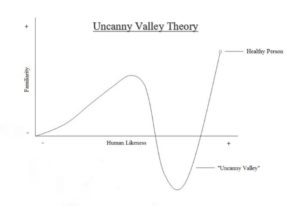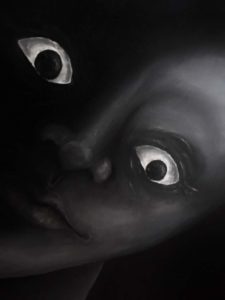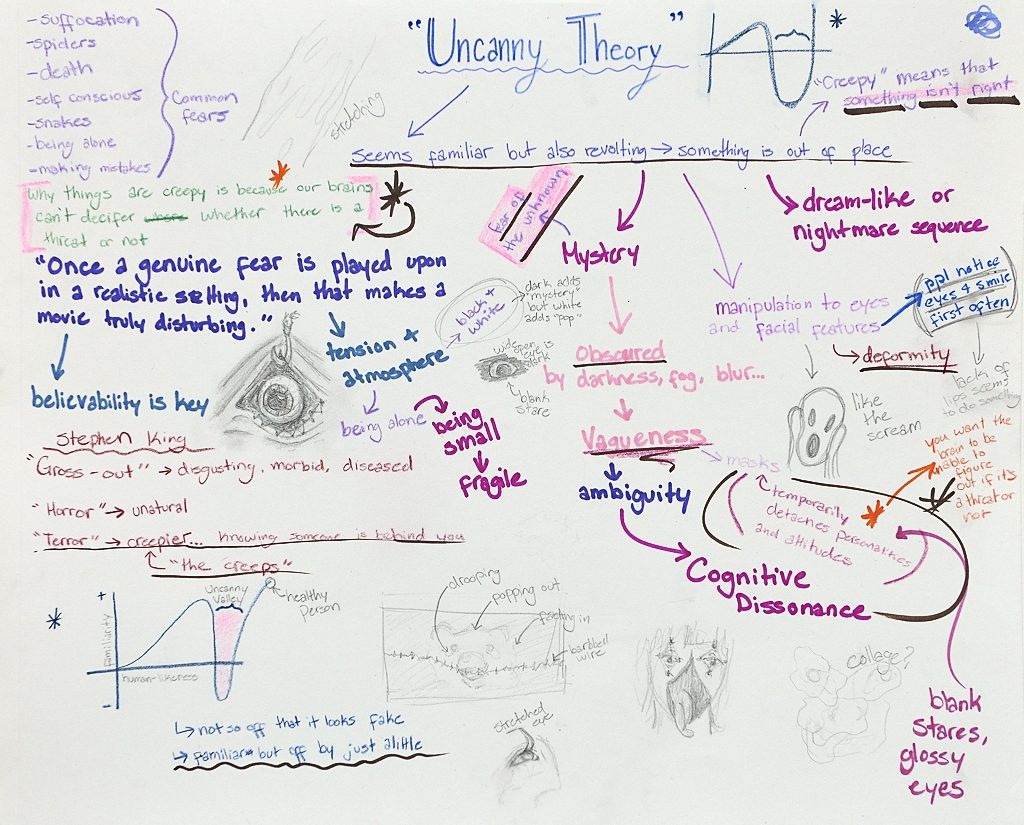Thing of the Valley
An Exploration of Oil Through Conceptual Means
According to the Uncanny Valley Theory, creepiness is expressed as a consequence of incredible human-likeness with a tangible sense that something isn’t right about the figure, creating a situation where our brains are unable to decipher whether a threat is present. The original ‘uncanny’ theory, first derived from Sigmund Feud’s 1919 essay, Das Unheimliche, has become indispensable to horror franchises as well as to psychologists expanding their understanding of cognitive human nature. As explained by the theory, cognitive dissonance (the uncomfortable feelings associated with a discrepancy between belief and behaviour) along with man’s inherent fear of the unknown is what is often referred to as ‘the creeps’.

With aid from the diagram, an understanding can be formed on the basis that, when something is so close to being a healthy person, but is slightly off, a feeling of creepiness is established. While humanoid robots are a prime example of an object that lies in the uncanny valley, in context of film or environments of horror, falling within the valley is a consequence of ambiguity, visual tension and limited discrepancies between realism and surrealism. Subsequently, the brain temporarily detaches personalities and attitudes from the figure, leaving your brain in a state of confusion, triggering cognitive dissonance. Although applied frequently in horror settings, creepiness is not defined and evoked by the same means as pure fear. As rationalised by Stephen King, horror is seeing the unnatural, morbid or disgusting monster following you; terror and creepiness is knowing someone is behind you but not being able to see them or know their intentions. While fear certainly can play a role, logic behind the uncanny valley lies in an incongruity in the flight or flight responses of the brain.
Complimenting the concept of ambiguity, the figure is slightly obscured by darkness, with the exception of the eyes. Placing the shadow to the left complements our left-to-right reading style, allowing for the figure to be revealed as we ‘read across’ the picture plane. Furthermore, the usage of black and white values emphasizes concepts of ambiguity through manipulation of atmosphere. Bold contrast between the sclera and the darker tones of the skin and surrounding environment creates visual tension and contributes to the shock factor of the piece. Additionally, the absence of an iris and the vagueness of highlights produces a blank expression, contributing to the brain’s detachment on the figure from personalities and attitudes. Moreover, usage of the diction “thing” in the title of the piece further suggests vagueness through the ambiguity of language. As people notice eyes and mouths primarily when approaching a human figure, slight manipulation and deformities (not so subtle they are invisible but not so extreme as to seem unrealistic) of facial features, as well as the upper body further create visual tension, contributing to the “something isn’t right” feel. For example, the proportions of the eyes are larger in width around the center, not only allowing them to appear open widely, but also to promote the feeling stated previously. Additionally, while the eyes themselves remain glossed over and “dead”, the slight tilt of the head communicates that the figure is watching and paying attention. Movement, being congruent with the contour of the human body, develops a sense of realism that aids in creating a believable atmosphere. Application of texture in the form of wrinkles around the eyes not only suggests realism through human imperfection, but the extent to which they are applied also indicates a sense of surrealism, contributing to cognitive dissonance.





